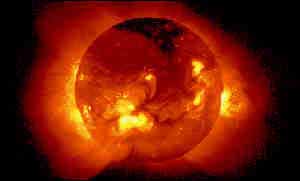What Is a Space Weather Forecast?
Space weather forecasts are issued by the Space Environment Center, a division of the U.S. Commerce Department's National Oceanic and Atmospheric Administration. That's the government agency which operates the National Weather Service.
Sunspots are explosions on the Sun. The level of explosive activity on the surface of the Sun rises and falls on an eleven-year cycle. Sunspots are building up to an expected peak in the second half of the year 2000.
 With a busy sunspot cycle under way around this turn of the century, the Space Environment Center forecasters are keeping the public informed about space weather with outlooks, watches and warnings like those ordinarily used for down-to-Earth weather.
With a busy sunspot cycle under way around this turn of the century, the Space Environment Center forecasters are keeping the public informed about space weather with outlooks, watches and warnings like those ordinarily used for down-to-Earth weather.Invisible Weather. Even though we can't see space weather like we might see a tornado, hurricane or blizzard, our high-tech environment can be disrupted by the electromagnetic storms that race across the 93 million miles of space separating us from the Sun.
When a space storm hit arrives at Earth, satellites, cell phones and computers can be knocked out. There can be electrical power blackouts. A 1989 storm blacked out the Quebec province of Canada.
The storms also allow people on Earth to see the aurora borealis -- northern lights -- as far south as the Gulf of Mexico.
The forecasters watch violent solar storms and alert the public and institutions that could be affected by space weather. Reports are sent out by the National Weather Service on its "Weather Wire" service to broadcasters, private forecasters and other users across the United States.
- Space weather reports discuss current conditions and outlooks and describe general expectations for future conditions.
- Space weather watches caution that severe space disturbances are expected.
- Space weather warnings say that events are imminent.
| Sun and Sunspots Index Page | |||||
|---|---|---|---|---|---|
| Learn More about Our Sun and Sunspots and Their Effects on Earth |
| Read more Space Today Online stories about the Solar System | |||||
|---|---|---|---|---|---|
| Star: | The Sun | ||||
| Inner Planets: | Mercury | Venus | Earth | Mars | |
| Outer Planets: | Jupiter | Saturn | Uranus | Neptune | Pluto |
| Other Bodies: | Moons | Asteroids | Comets | ||
| Beyond: | Pioneers | Voyagers | |||
| Top of this page | Solar System index | Space Today Online cover |